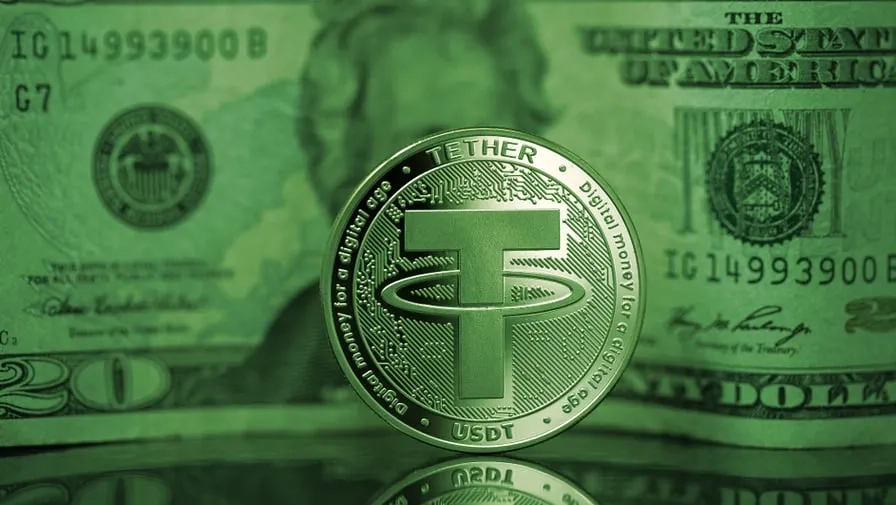The concept of ‘doomsday’ investing has gained significant attention as investors seek safe-haven assets to protect their wealth during global crises.
In the realm of cryptocurrency, Tether emerges as a potential safe haven due to its stablecoin nature, pegged to the US dollar.
The idea behind ‘doomsday’ investing is to prepare for extreme financial scenarios, and investors are looking for assets that can retain value or increase in worth during such times.
Key Takeaways
- ‘Doomsday’ investing involves seeking safe-haven assets during global crises.
- Tether is considered a potential safe haven due to its stability.
- The stablecoin nature of Tether makes it an attractive option.
- Investors are looking for assets that can retain value during extreme financial scenarios.
- Tether’s peg to the US dollar adds to its perceived safety.
Understanding Tether and Stablecoins
As global financial uncertainty looms, investors are turning to Tether, a stablecoin pegged to the US dollar, for safe investment opportunities. Tether, or USDT, has become a cornerstone in the cryptocurrency market, providing a stable store of value and medium of exchange.
What is Tether (USDT)?
Tether is a type of cryptocurrency known as a stablecoin, designed to maintain a stable value relative to a traditional currency, in this case, the US dollar. This stability is achieved by pegging the value of Tether to the dollar, theoretically maintaining a 1:1 ratio.
How Tether Maintains Its Dollar Peg
Tether maintains its dollar peg through a reserve system, where each USDT token is supposedly backed by an equivalent amount of US dollars held in reserve. This reserve is intended to ensure that Tether’s value remains stable and trustworthy.

Tether’s Market Position in the Cryptocurrency Ecosystem
Tether is the largest stablecoin by market capitalization, making it a significant player in the cryptocurrency ecosystem. Its widespread adoption and liquidity have cemented its role as a safe haven during market downturns and global crises.
The Technology Behind Tether
The technology behind Tether involves a combination of blockchain technology and the traditional financial system. Tether tokens are issued on various blockchain platforms, including Ethereum and Tron, allowing for fast, secure transactions while maintaining the stability associated with the US dollar.
Tether’s unique position in the market offers investors a safe investment option during times of financial uncertainty, making it a crucial component of a diversified investment portfolio aimed at mitigating risks associated with global crises and enhancing financial security.
- Tether provides a stable store of value.
- It is widely used in the cryptocurrency market.
- Tether’s value is pegged to the US dollar.
The Concept of ‘Doomsday’ Investing
As global economic instability looms, the idea of ‘doomsday’ investing has become increasingly relevant. This investment strategy involves preparing for potential financial crises by diversifying portfolios and allocating assets to safe-haven instruments.
Defining Financial Crisis Preparedness
Financial crisis preparedness refers to the measures taken by investors to mitigate potential losses during economic downturns. This includes diversifying investments across various asset classes and allocating a portion of the portfolio to safe-haven assets.
Traditional Safe-Haven Assets
Traditionally, investors have turned to assets such as gold, government bonds, and cash reserves as safe havens during times of financial uncertainty.
Gold and Precious Metals
Gold and other precious metals have long been considered a store of value during economic crises. They tend to maintain their value or even appreciate when other assets decline.
Government Bonds
Government bonds, particularly those issued by stable governments, are seen as a low-risk investment. They provide a relatively stable source of returns, even in times of financial turmoil.
Cash Reserves
Maintaining cash reserves is another strategy for weathering financial storms. Cash provides liquidity and can be used to capitalize on investment opportunities during downturns.
The Rise of Digital Safe Havens
The emergence of cryptocurrencies, such as Tether (USDT), has introduced new options for investors seeking safe havens. These digital assets offer an alternative to traditional safe-haven assets, with the potential for greater liquidity and accessibility.
Psychology of Crisis Investing
The psychology behind crisis investing is complex, driven by factors such as fear, risk aversion, and the desire for security. Understanding these psychological factors is crucial for making informed investment decisions during times of financial uncertainty.
Some key considerations for investors include:
- Assessing risk tolerance and adjusting portfolios accordingly
- Diversifying investments to minimize exposure to any one asset class
- Staying informed about market trends and economic indicators
Investing in ‘Doomsday’! Is Tether a Safe Option During Global Crises?
Tether’s role as a stablecoin has positioned it as a potential safe haven during global financial crises, warranting a closer examination of its performance.
Tether’s Performance During Previous Market Downturns
Tether’s stability during past market downturns is crucial in assessing its viability as a safe-haven asset. Two significant events that tested Tether’s resilience were the 2020 COVID-19 crash and the 2022 crypto winter.
2020 COVID-19 Crash
During the 2020 COVID-19 pandemic, global markets experienced unprecedented volatility. Tether maintained its peg to the US dollar, providing a stable store of value for investors.
2022 Crypto Winter
The 2022 crypto winter saw a significant downturn in the cryptocurrency market. Tether continued to maintain its stability, with its market capitalization increasing as investors sought safe-haven assets.
Accessibility and Liquidity Advantages
Tether offers several advantages in terms of accessibility and liquidity. It is widely supported by most cryptocurrency exchanges and can be easily transferred between wallets.
Key Benefits:
- High liquidity
- Wide acceptance
- Easy transferability
Comparison to Other Crisis-Resistant Assets
Tether is not the only asset considered safe during crises. Other assets like gold, fiat currencies, and other stablecoins also attract investors seeking stability.
Gold vs. Tether
Gold has traditionally been a safe-haven asset. Unlike Tether, gold’s value is not pegged to any currency, and its price can fluctuate based on market demand.
Fiat Currency vs. Tether
Fiat currencies, especially the US dollar, are considered safe-haven assets. Tether, being pegged to the US dollar, offers a digital alternative with the benefits of blockchain technology.
Other Stablecoins vs. Tether
Other stablecoins like USDC and DAI also offer stability. However, Tether’s market dominance and widespread adoption set it apart.
| Asset | Liquidity | Stability | Adoption |
|---|---|---|---|
| Tether | High | High | Very High |
| Gold | High | High | Very High |
| USDC | Medium | High | High |
Practical Implementation of Tether in a Crisis Portfolio
Tether can be a valuable component of a crisis portfolio when implemented thoughtfully. Investors seeking to leverage Tether as a safe-haven asset must consider several critical factors to maximize its effectiveness.
Allocation Strategies and Percentages
Determining the optimal allocation to Tether depends on individual risk tolerance and investment goals. A common strategy is to allocate a percentage of the portfolio that aligns with the investor’s risk management needs. For instance, conservative investors might allocate a larger percentage to Tether to enhance the portfolio’s stability during market downturns.
Storage and Security Considerations
Secure storage is paramount when holding Tether or any other cryptocurrency. Investors have two primary options: hardware wallets and exchange custody.
Hardware Wallets
Hardware wallets offer a high level of security by storing private keys offline, reducing the risk of hacking. They are particularly suitable for long-term holdings.
Exchange Custody
Exchange custody provides convenience and liquidity, allowing for quick responses to market movements. However, it comes with higher risks, such as exchange hacks. Investors must weigh these risks against the benefits.
Liquidity Planning for Emergencies
Effective liquidity planning is crucial for accessing Tether during emergencies. Investors should ensure that their Tether holdings are readily accessible without significant penalties or losses.
Tax Implications in the United States
Holding Tether in the United States comes with tax implications. The IRS treats Tether as property for tax purposes, subjecting it to capital gains tax. Investors must report gains or losses on their tax returns, making it essential to maintain accurate records of transactions.
By carefully considering allocation strategies, storage and security, liquidity planning, and tax implications, investors can effectively integrate Tether into their crisis portfolios, enhancing their risk management capabilities.
Risks and Limitations of Tether as a Safe Haven
As a prominent stablecoin, Tether’s viability as a safe-haven asset is challenged by regulatory, technical, and operational risks. Investors seeking to utilize Tether as a hedge against financial crises must be aware of these potential pitfalls.
Regulatory Concerns and Legal Challenges
Tether operates in a complex regulatory environment. Legal challenges and regulatory scrutiny have been ongoing concerns, potentially impacting its stability and usability. For instance, Tether has faced issues related to its compliance with anti-money laundering (AML) and know-your-customer (KYC) regulations.
Reserve Transparency Issues
A significant concern surrounding Tether is the transparency of its reserves. Questions have been raised about whether Tether is fully backed by USD, as claimed. This lack of clear transparency can erode trust and potentially destabilize the asset during times of stress.
Technical and Operational Risks
Tether’s infrastructure is not immune to technical risks. Blockchain vulnerabilities and exchange dependencies are critical concerns.
Blockchain Vulnerabilities
The underlying blockchain technology that Tether relies on can be susceptible to vulnerabilities, such as smart contract risks or 51% attacks, although Tether primarily uses more secure chains like Ethereum and Tron.
Exchange Dependencies
Tether’s usability is heavily dependent on its availability on major cryptocurrency exchanges. Any issues with these exchanges, such as hacks or operational halts, can impact Tether’s liquidity and stability.
Counterparty Risk in Extreme Scenarios
In extreme scenarios, such as a global financial crisis, counterparty risk becomes a significant concern. This refers to the risk that the other party in a transaction (e.g., an exchange or a bank holding Tether’s reserves) fails to fulfill their obligations.
Internet Dependency During True “Doomsday” Events
Tether, like other digital assets, is dependent on internet connectivity. In a true “doomsday” scenario where internet infrastructure is compromised, Tether’s usability could be severely impaired.
In conclusion, while Tether offers certain benefits as a stablecoin, its risks and limitations must be carefully weighed by investors. Understanding these challenges is crucial for making informed decisions about its role in a crisis portfolio.
Conclusion: Is Tether Truly a ‘Doomsday’ Safe Haven?
Tether’s viability as a safe-haven asset during global crises is a complex issue. Throughout this article, we have examined the concept of ‘doomsday’ investing and Tether’s role within it. By understanding Tether’s mechanics, its performance during market downturns, and the associated risks, investors can make informed decisions about their financial security.
Investing in ‘doomsday’ scenarios requires careful consideration of assets that can provide stability. Tether’s dollar peg and liquidity advantages make it an attractive option. However, regulatory concerns, reserve transparency issues, and technical risks must be weighed against its potential benefits.
Ultimately, whether Tether is a true ‘doomsday’ safe haven depends on individual investor priorities and risk tolerance. As part of a diversified portfolio, Tether can contribute to financial security during times of crisis. Nonetheless, it is crucial to remain aware of the potential risks and limitations associated with Tether and other stablecoins.

